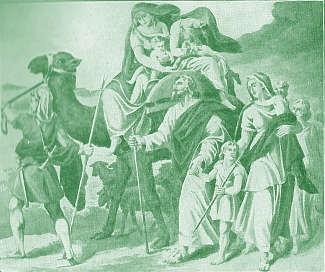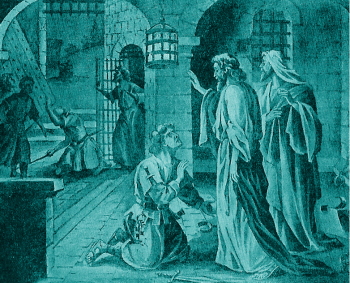
Basic Elements of Christianity
Understanding the Holy Bible,Part 2
21(5/9)

Basic Elements of Christianity
Understanding the Holy Bible,Part 2
21(5/9)
 Passages of the Holy Bible must be taken literally unless it is absolutely clear that a passage contains terms that are symbolic or representative, a figure of speech is involved, or for similar reasons. As you grow in Christ, the Holy Spirit will sharpen your spiritual discernment to enable you to sense better when something should be taken as other than literal.
Passages of the Holy Bible must be taken literally unless it is absolutely clear that a passage contains terms that are symbolic or representative, a figure of speech is involved, or for similar reasons. As you grow in Christ, the Holy Spirit will sharpen your spiritual discernment to enable you to sense better when something should be taken as other than literal.
Some people view the account of the creation of Adam and Eve as figurative. To some of these people, the original couple was just a story to explain how humans came into existence, how sin entered the world, and so on. However, both Adam and Eve are referred to in the literal sense in the New Testament as well as their actions. Besides, if Adam and Eve are figurative, at what point in Genesis does its accounts switch from figurative to literal? It was said one time that the two main books the devil attacks are Genesis and The Revelation, because his defeat is prophesied in Genesis and it is carried out in Revelation.
There will be things difficult for us to understand, but that does not mean what we read is not literal. We need to understand that God has higher ways than we do. So, when you read something like Ephesians 2:6, "And hath raised us up together, and made us sit together in heavenly places in Christ Jesus," you can take that literally, just as I previously mentioned that if one is truly saved, they are actually co-crucified with Christ (Gal. 2:20).
While there are some non-literal portions and phrases in the Holy Bible, there are no myths set forth as fact. For example, the Word of God mentions the gods Dagon and Zeus but clearly shows these were false beliefs. The Gospel opposes mythology (Ezekiel 8:13-14, Acts 14:8-18). If you have ever read mythology from any society and then objectively compared it to the Holy Bible you would see a stark contrast. For one thing, mythological gods are as sinful as humans.
The sinful nature of man prefers not to take a literal approach to the Holy Bible, since the literal approach would kill the sin nature and let the Life of Christ flow in and through us. The non-literal path for the entire Holy Bible leads to moral, doctrinal, and spiritual failure.

When you meet with phrases and passages that obviously are not to be taken literally, such as certain figures of speech, then ascertain their meaning by the direction of the Holy Spirit and other principles of interpretation that would be applicable.
Here's an example of how something can be cleared up by checking the language. If you have a KJV, you will see in Galatians 6:2 we are to bear one another's burdens, but in 6:5 every man should bear their own burden. Check the Greek and you will see verse 2 means the emotional burdens and verse 5 means the share of work. However, if one carefully and prayerfully reads that paragraph, you will see words and phrases that would indicate that two different types of burdens are mentioned.
Let us go one step deeper. Please read Acts 9:1-7. Note verse 7 and compare it with Acts 22:9. You will see the former states the men with Paul heard a voice but the latter states they did not. However if you make a quick check of the Greek you will find that the word for voice, which is pronounced as pho-nay, is used in both passages. The same Greek word is being used, so is this a contradiction? Looking at the definition of pho-nay, if you can, you will discover it is translated in at least two ways: voice and sound. So, apparently Acts 9 indicates the men heard a sound, but Acts 22 tells us they heard no voice. This distinction between these two verses becomes more clear when we consider that Paul said (immediate context), “... the voice of him that spake to me,” not the "sound of Him..." At times, the voice of God, while understood by some might be understood by others as just a “sound.” See John 12:27-30.
To the right (or above on the right depending how the size of the text is set on your computer) is a chart showing how to check the words used in the original languages. The top part is an example of just using books, and I have selected the word "ark" to check. Figure 1 (a white number 1 on a blue background) is a view of a list of verses in Strong's Exhaustive Concordance that list the term. As you see in the right of that figure there are some numbers indicating which Hebrew word is being used in each verse. Note that all the verses containing ark in Genesis, and the first two listed in Exodus have the reference number of 8392. Others in Exodus indicate 727. In figure 2 I looked up 8392. It simply indicates ark. When I checked 727 (figure 3) it indicated that Hebrew word could possibly be translated, ark, chest, coffin, and essentially a box. Figure 4 shows that Wilson's Old Testament Word Studies (WOTWS) gave additional details. Looking at the context of all the verses and given the definitions we found, the Hebrew word listed as 8392 is a boat and 727 is used in relation to the Ark Of The Testimony that was carried over land.
The bottom portion shows how I check words with the computer program, Online Bible. It's name state's "Online" but you actually download it. You can download various versions, commentaries, extrabiblical books, and more. Some time back I was interested in the word "portion" in Psalm 119:57. So I (1) clicked on file and selected "open passage" and made my selection. When the passage came up, I (2) clicked on view and selected "Strong's." That displayed the Strong's reference numbers next to each word. For verbs it will also give another number for tense and other matters. (3) Double clicking on the reference number gave me the definition. For more insight, (4) I went to WOTWS. Wilson's lists the possible Hebrew words for the English words you might find. It then lists the verses indicating by reference number which word in the text is used in each verse. For "portion," there were 12 words. In the list of verses, Psalm 119:57 was not listed, but a note above indicated those verses not listed used the Hebrew word referenced as number 6 of the words that could be translated "portion." That word occurred enough times in the OT for Wilson just to make a general reference to it. In figure 4 you see it's definition. The other Hebrew words had different shades of meaning.
One other thing to keep in mind is a word in the ancient language might sometimes be defined by its context. This also happens in many other languages, including English, where one could say, "The sun is shining so it's going to be a great day...," or "In this present day there is less discipline in schools." By context we understand the former sentence refers to a portion of twenty-four hours, but the latter sentence could mean a long range of time which includes years.
Important Note: LORD and Lord
In some versions in the OT you will encounter "LORD" and "Lord." Regarding "LORD," the Name of God was too sacred for devout Jews to write upon material that eventually would decay so just the Hebrew consonants were used. Transliterated those consonants would be YHWH or YHVH (Anglicized by some as JHVH). Hence, these are the terms "Yahweh", "Yahveh", and "Jehovah" respectively, but based upon assumptions as to what the vowels were. I prefer YHVH since, for consonants, there is no "J" sound in the Hebrew and it seems to me the sound of "v" occurs for the second half. If you see "the LORD" in a version it most likely means "YHWH / YHVH / JHVH." Feel free to read to it as "Yahweh", "Yahveh", or "Jehovah."
YHWH, YHVH and JHVH are sometimes referred to as the Tetragrammaton. Some recent versions have replaced LORD with YHWH , Yahweh, YHVH, Yahveh, JHVH or Jehovah. Now that you know this, beginning at this point in your lessons from time to time I will be using mainly YHVH whenever the Holy Scriptures indicate it.
"Lord" is from "adon" or "adonai" and can refer to God, humans or angels depending upon grammar and / or context. Note "Lord (adonai) of lords (adonai)" in Deu. 10:17 and Psa. 136:3.
|
Truth: A Moving Target For |
Keep in mind the ancient languages are somewhat different at times than our English and most other contemporary languages. For example, in English we might say “the (definite article) bird,” or “a (indefinite article) bird.” There are no written indefinite articles in the Greek. So when a noun does not have a definite article (or, simply, article) with it, most times it is to be translated as having an indefinite article with it. However, I said “most times.” J. Gresham Machen writes1, “Certain nouns, referring to person or things which instead of being only one of a class are quite unique, are treated as proper nouns, the article being either inserted or omitted.” They include, but are not limited to, the words God, Spirit, world, and Law. It is partly based on this rule that a true translation of the Bible will translate John 1:1c as, "the Word was God."
Here is another interesting thing about the Greek. There's the imperfect tense where the action is ongoing in the past. It often occurs in narratives, and, when so, instead of, "Jesus said unto him...," it's more like, "so Jesus was saying to him..."
Some words in Hebrew are always written in plural2, one of which is one word for God: Elohim. In the case of Elohim, when the One true God is spoken of, the verb in the sentence or clause is singular, indicating the subject is not many Gods, but the one true God. This is the case for Genesis 1:1. Just so you know, sky (heaven), face, and Jerusalem are some more words that are always written plural in Hebrew.
This is one reason why by the Holy Spirit God introduces Himself as “Elohim” in Genesis 1:1, then “YHVH Elohim” in 2:4, “YHVH” in Genesis 4, and later the attributes of God added to “YHVH.”
Not only did He progressively revealed Himself, but His principles, prophecy and so on. One example in regard to His principles is that when Christ taught as recorded in Matthew 5, He mentioned “you shall not kill (murder)” and then went deeper into that command, getting to the root of the problem, our sin nature: {*}“You have heard that it was said by them of old time, You shall not kill; and whosoever shall kill shall be in danger of the judgment: 22 But I say unto you, That whosoever is angry with his brother without a cause shall be in danger of the judgment: and whosoever shall say to his brother, Raca, shall be in danger of the council: but whosoever shall say, Thou fool, shall be in danger of hell fire. 23 Therefore if thou bring thy gift to the altar, and there remember that thy brother has ought against you; 24 Leave your gift before the altar, and go your way; first be reconciled to your brother, and then come and offer your gift.”
Regarding Christ Himself and progressive revelation, it is written in Galatians 3:24 where Paul, who was raised in Judaism, writes by the Holy Spirit, that "Wherefore the law was our schoolmaster to bring us unto Christ, that we might be justified by faith."
Since I mentioned prophecy above in regard to progressive revelation I will bring just one thing out for the sake of brevity. Case in point would be Genesis 3:15, “And I will put enmity between you and the woman, and between your seed and her seed; He shall bruise your head, and you shall bruise his heel.” That is first the indicator of the fact that Christ would provide redemption for mankind. One of the greatest expansions of that revelation is found in Isaiah 53.
Before we leave this principle it needs to be said that progressive revelation does not mean the Old Testament (OT) is “less than” or inferior to the New Testament. There are many deep truths in the Old Testament. We are to remember that the Holy Bible is one.
Some see "two Gods" when looking at the Holy Bible: the tough, vengeful God of the OT, and the soft, merciful God of the NT. However, objectively looking at the Holy Bible we will see that God is also shown merciful in the OT, and also vengeful in the NT.
Some see "two Gods" when looking at the Bible: the tough, vengeful God of the OT, and the soft, merciful God of the NT. However, objectively looking at the Holy Bible we will see that God is also shown merciful in the OT, and also vengeful in the NT.
Messianic: This is a type of prophetic passage that focuses mainly upon the Messiah (Christ). Psalm 2 is one of many Messianic psalms.
Much later in this course you will have a lesson about futuristic Holy Bible prophecy.
Accommodation in presentation also occurs in figures of speech at times (see the example just below about God "baring His arm").
|
You will not be quizzed on these.
Anthropomorphism - For our current purposes spiritual aspects of God such as His authority and any of His attributes and actions expressed in human form, e.g., Psa. 108:9.
Apostrophe - ... an address to the absent as though present, e.g., Jer. 15:10, or to the inanimate as if human Psalm 68:16.
Fable - ... a story in which nature and the brute creation are endowed with reason and made to speak and act contrary to the known laws of their being, e.g., Judges 9:8-15.
Hyperbole - ... a figure of speech consisting of an obvious exaggeration not intended to deceive, but to add force to a statement, e.g., Psa. 6:6.
Interrogation - ... a figure of speech in which an assertion or affirmation is expressed in the form of a question, e.g., Job 11:7; Jer. 32:27.
Irony - ... figure of speech in which the very opposite of what is intended is said, e.g., Job 12:2.
Litotes - ...suggests its intended idea by negating the opposite, e.g., Acts 21:39. It is an understatement in contrast to the hyperbole which emphasizes by overstatement.
Metaphor -... an implied comparison in which a transfer of the qualities of one object to another is made so that an identity is established between them, Matt. 5:13.
Metonymy - One word is substituted for another because of an association of ideas, e.g., 1 Ch. 17:12 (throne for kingship).
Onomatopoeia - ...the use of words whose sound suggests the sense, e.g., Matt. 24:51.
Personification- ...intelligence or life is attributed to inanimate objects, e.g., Num. 16:32.
Riddle - ... a proposition put in ambiguous language intended to puzzle or perplex the hearers and requiring the exercise of ingenuity in order to discover its meaning, e.g., Judges 14:14.
Simile - ... a comparison between two fundamentally different objects for the purpose of bringing out some point of resemblance. Similes are usually introduced by words such as "like" or "as," e.g., Jer. 23:29.
Synecdoche -...a specialized type of metonymy in which the whole is put
for a part, e.g., Luke 2:1: or the part is put for the whole, e.g., Psalm 24:4 (clean hands and a pure heart representing the whole person).
|
While we will specifically look at parables, allegories and paradoxes, to the right, Walter Beuttler4 points out a number of figures of speech in the Word of God. You will not be quizzed on the definitions provided in this chart.
In regard to allegories, Beuttler5 writes . . .
"a. Allegory defined - An allegory is an extended metaphor which presents a spiritual truth in symbolical narrative, Ecc. 12:6.
b. Allegory and parable differentiated:
(a) The personages in the parable are representative, e.g., Matt. 13:3-9, while those of an allegory are symbolical, e.g., Ecc. 12:6.
(b) The meaning of the parable is to be sought apart from the imagery of the story, while the meaning of the allegory is implied in the symbolical use of the words."
Just like our poetry, there are times unnatural attributes are given to certain things to express a thought in a powerful way. We are to focus upon that powerful thought of course. In this, and in other cases when it would not be sensible or be against the other principles of interpretation to take what is written absolutely literal we are to focus upon that powerful thought of course.
There are also times that the Holy Spirit permitted the human authors to express emotions you and I would shrink from. For example, read Psalm 137 where the psalmist vents his emotions in regard to how the Jews were treated by the Babylonian captors. The concluding verse states, "Happy shall he be, that taketh and dasheth thy little ones against the stones." One thing the Holy Spirit is showing us is the deep, grievous hurt the Jews felt as they fell prey to their human enemies after falling prey to sin.
Figures of speech and accommodation in presentation are often interwoven within Biblical poetry.
Prophetic passages are sometimes poetically written, totally or in part.

In Acts 16:31 Paul and Silas told the Philippian jailor, "Believe on the Lord Jesus Christ, and thou shalt be saved, and thy house." Some have taken this as a promise that if a person believes to salvation, everyone in their household will believe unto salvation. This is not necessarily so. The jailor's household was apparently more receptive to the Gospel than many households today. There are numerous people who have truly committed to Christ, but their family has not. Consider what Christ said in Luke 12:51-53: "Suppose ye that I am come to give peace on earth? I tell you, Nay; but rather division: For from henceforth there shall be five in one house divided, three against two, and two against three. The father shall be divided against the son, and the son against the father; the mother against the daughter, and the daughter against the mother; the mother in law against her daughter in law, and the daughter in law against her mother in law."
Beuttler6 writes:
Before we continue, it needs to be said the literal aspects of a symbol are not necessarily to be laid aside just because something could be symbolic. For example, concerning Zacharias’ service in the Temple, we read in Luke 1:11, “And there appeared unto him an angel of the Lord standing on the right side of the altar of incense.” All of that, of course, is literal. It actually occurred. But the fact that an angel of the Lord, which we later read is Gabriel, standing on the right side of the altar of incense is significant. The Word could have just said the angel was standing by the altar, but it is specifically brought out that the position of the angel was at the right side of the altar. As you read the Holy Scriptures you would learn this speaks of authority, and that point is underscored by the fact that Gabriel said he stands in the presence of God (verse 19). As you continue to read this account in Luke you see Gabriel not only tells Zacharias he will have a son, but announces the purpose of that son which would be connected with the fact Messiah would soon be born.
To be sure of their meanings, we can usually find out what symbols mean by going to the first time they were used in the Holy Bible, or view how they are used throughout the Holy Bible. We can also learn what they mean from their context and other principles of interpretation.
A symbol might have more than one meaning or one or more of its qualities applied to two different entities. Context, again, will help to determine that. For example, the term “lion” is used in 1 Peter 5:8 to convey the devil's destructiveness, but it is used for the kingship of Christ in Rev. 5:5.
Clothing in God's Word is often symbolic of righteousness, whether it is ungodly self-righteousness or God-given righteousness. A rainbow speaks of God's faithfulness in keeping His promises.
Numbers often symbolically carry meaning. Here are a few examples:
One-God, unity, beginning
Two-Witness, division (as in one person against another), multiplication in blessing or punishment.
Three-Trinity, strength, completeness
Four-Universal, fullness
Five-Congregational (based on the usage of five in the construction of the Tabernacle)
Six-Man
Seven-Spiritual perfection, completeness
Eight-New beginning
Ten-Order
I did not include nine because the occurrence of that number throughout the Word of God is very low and I would say it has no significance. You will find books and web sites that find symbolism in just about every word of the Bible, which is definitely not the intent of the Holy Bible. What makes something symbolic is how the Bible uses it, not what man wants to assign to it.
I will now give you another series, but that should be sufficient for now since much could be said about symbols. Colors:
Black-Sin, death, guilt, deepness, mystery etc. But, in the Old Testament, depending on what Hebrew word is used it could point to something like spiritual healing. Consider Song Of Solomon 1:5 .
Blue-Heaven, heavenly, etc.
Gold-Godliness, the victorious life of Christ (tested at all points), superior, etc.
Green-Life
Red (and crimson, scarlet)-War, redemption, sacrifice, etc.
Purple (violet, etc.)-Royalty
White-Purity, innocence, clean, etc.
Silver-Deity, godliness, The Word of God, etc.
Bronze, Brazen - Often associated with judgment
Test your knowledge and skill in this quiz. English only.
--------------
1Machen, J. Gresham: New Testament Greek For Beginners (The MacMillan Company, Toronto [copyright 1951 Arthur W. Machen]), p141
2Ancient Hebrew Research Center--http://www.ancient-hebrew.org/42_lesson03.html
3Ramm, Bernard: Protestant Biblical Interpretation (Boston: W. A. Wilde, 1956) p110
4Except for "anthropomorphism," Beuttler, Walter: Principles of Bible Interpretation (publisher, location of publisher, date are unknown), selected. (This study by Beuttler, along with some others I have, were sent to me via e-mail by Brother Ken Madden, to whom I am grateful.)
5Beuttler - same
6Beuttler - same
7Beuttler - same
{*} From the KJV but modified by me for easier reading, so elsewhere where "ye" is replaced by "you," "thy" replaced by "your," and so on.
Continue to the next lesson,
The Holy Spirit and His Riches
Lesson Menu
View the Glossary
Go to the Index
Abbreviations and about Reference Notations